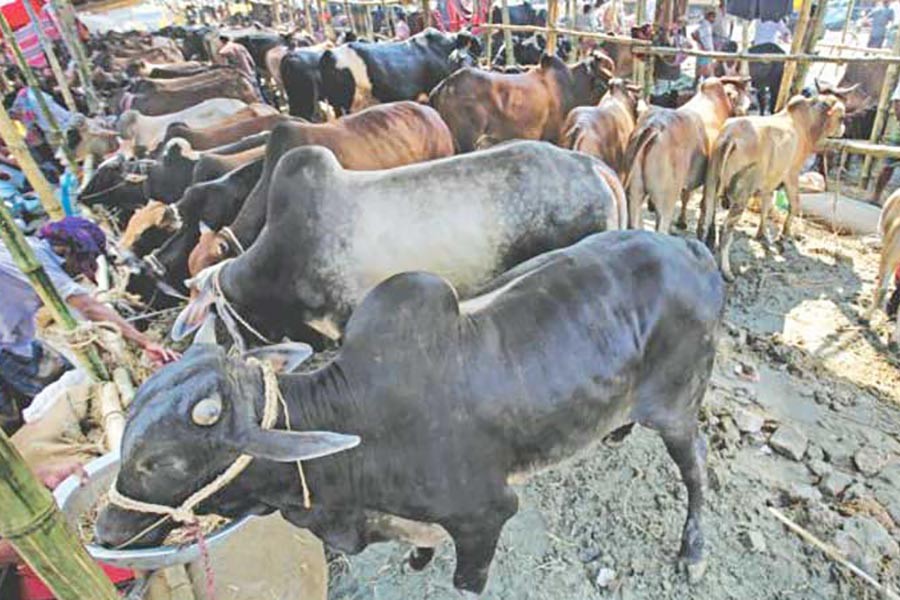
Published :
Updated :

The festival of Eid-ul-Azha and all the different activities related with the festival have a tremendous impact on the socio-economic conditions of the country. Eid-ul-Azha corresponds with Hajj (pilgrimage) to Mecca by the financially able Muslims. This year, around 110,000 pilgrims from Bangladesh have gone to Saudi Arabia to perform Hajj. Each pilgrim is expected to spend, on average, Tk 500 thousand (Taka five lakhs). That means there will be a total expenditure of Tk 500 billion by all the pilgrims from Bangladesh this year. This is equivalent to US $ 415 million. The Hajj has been a major source of foreign currency for the Saudi economy since the earliest days when the Hajj was introduced. It is an important source for foreign currency exchange for other economies as well. Bangladesh economy has to handle banking transactions along with foreign currency exchanges and job creation to help the pilgrims.
Eid-ul-Azha, or Feast of the Sacrifice, is celebrated by Muslims all over the world to mark the readiness of prophet Ibrahim to sacrifice his dearest son Ismail as an act of obedience to Allah, before the Almighty intervened to provide him with a sheep to sacrifice instead. The basis for Eid-ul-Azha comes from the 196th verse of Surah Baqara (The Cow) in the Quran. The word 'Eid' also appears in Surah al-Mai'da (The Table Spread) of the Quran, meaning 'solemn festival'. The days of Eid-ul-Azha are from Dhul Hijjah 10 until Dhul Hijjah 12 (three days and two nights). During these days, animal sacrifice can take place until sunset of Dhul Hijjah 13. In the Indian subcontinent, the festival is known as 'Bakri Eid' due to the tradition of sacrificing goats.
Sacrificing cattle has been the central focus for Muslims across the world during Eid-ul-Azha. This entails financial involvement which spurs economic activities. According to Bangladesh Tanners' Association (BTA), about 35,000 cows and five million goats will be sacrificed this year. They hope that the total trading involved will be worth Tk 160 billion.
Bangladesh is heavily dependent on supply of cattle from India. India exports about 10 million cattle to Bangladesh annually, out of which around four million are consumed during Eid. The import of cows, through both informal and formal process, helps the Bangladesh government earn Tk 2.0 billion.
Eid-ul-Azha is also the main season for producing leather. Nearly 60 per cent of the annual export of leather from Bangladesh occurs after the celebration of this festival. Markets for spices and electronic goods like refrigerators enjoy bumper sales during this time. The total worth of this Eid sale hovers around Tk 100 billion.
The money market, which usually gets volatile during Eid festivals, remains calm during this Eid and ahead of Durga Puja. For example, the market is now in a calm state due to a decline in imports and a rise in remittances.
The performance of Hajj and sacrifice of cattle during Eid-ul-Azha generate money supply, promote trade and business, create jobs, and overall, helps the economy. Competent macro management of such supply side economy can prove to be crucial for sustainable development. The cost-effectiveness of Hajj management can be more in favour of the economy if infrastructural facilities were available to commute and accommodate major portion of pilgrims, if not all, in an effective and efficient manner.
The management of cattle as well as leather trading can fairly benefit the economy if a far-sighted plan is in place to handle border trade, check corruption and other irregularities by the so-called syndicates.
It has been observed in the past that Eid cattle market is dependent on the three S -syndicated traders, smugglers and snatchers. It is reported that syndicated traders have targeted a market of Tk 320 billion from Bangladesh this time. They hope to earn this amount of money by exporting cow on credit and at the same time by importing raw hides at lower prices through unofficial channels. Against smuggled cows, they would receive raw hides and bone, fuel, edible oil, gold, silver, cigarettes, jute and more. In the process, Bangladesh economy loses huge revenue and some portion of potential international customers who would have otherwise imported leather and leather products from the country. Although the government provides credit facilities to tanneries, no credit is given to hide merchants who face various difficulties to run their businesses. As a result, the businessmen have to depend on smugglers who give advance money to procure leather.
For preservation of raw hide, salt is an essential ingredient. The government has been urged to allow duty-free import of 40,000 tonnes of salt to overcome any ploy by salt traders syndicate to hike prices.
Cattle from border areas to different places of the country including Dhaka have to pay illegal tolls at different places. Toll collectors make money by exploiting the situation. Better management is required to ensure that an authentic prospect for the economy is not lost.
Muhammad Abdul Mazid is a former secretary and chairman at the National Board of Revenue


 For all latest news, follow The Financial Express Google News channel.
For all latest news, follow The Financial Express Google News channel.